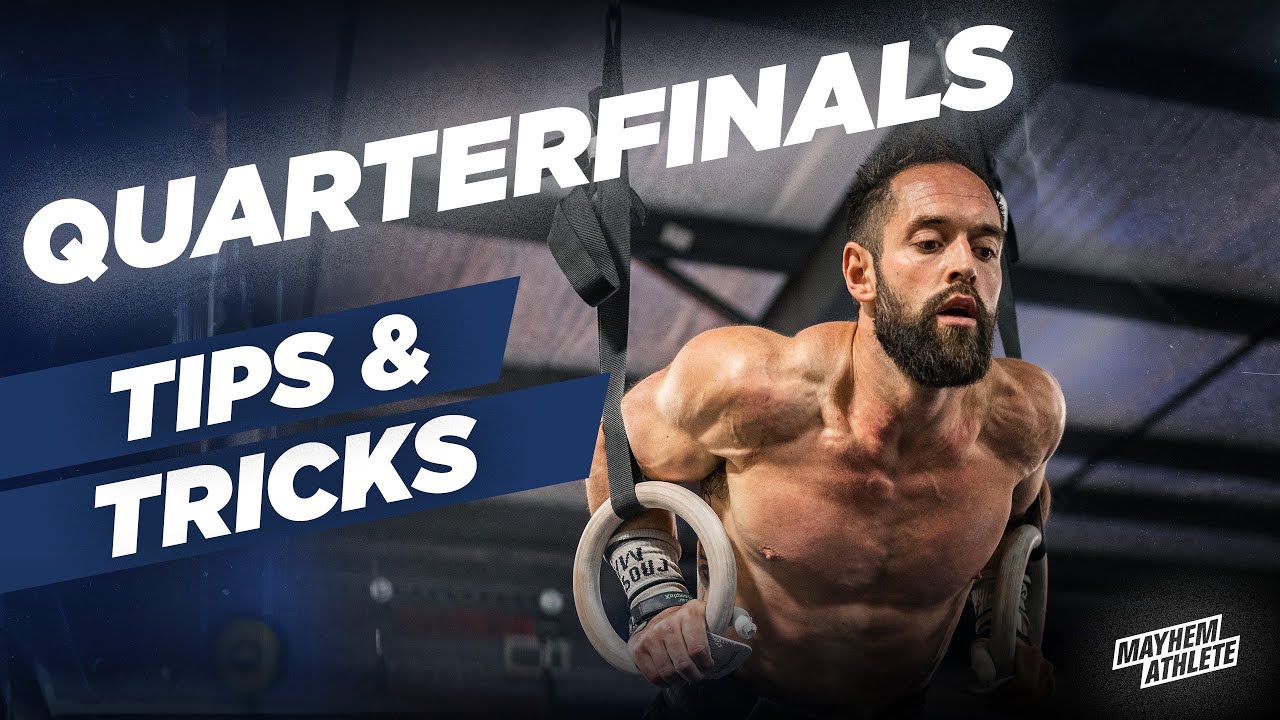Ready to push yourself to the next level in the CrossFit Quarterfinals?
Legendary athlete Rich Froning is offering his expert advice to help you crush the 2024 Individual Quarterfinals!
Master the unique challenges of each intense workout and learn strategies to optimize your performance. Froning reveals insider tips for pacing, technique, and how to prime your body for success.
Jump to:
Event Overview and Execution Strategy
Detailed Strategy for Workout 1: Snatch, Row, and Dumbbell Step-Ups
Preparation and Warm-up
Proper preparation for the first workout of the 2024 Quarterfinals begins with a comprehensive warm-up designed to activate and prepare the necessary muscle groups for optimal performance.
Banded Lat Rows:
Start with 8-10 reps of banded lat rows to engage the back muscles crucial for stability during snatches and power during rows.
Technique: Secure a resistance band at waist height. Facing the anchor point, hold the band with both hands and step back until there is slight tension. Bend at the hips, extend your arms, then pull the band towards your waist while squeezing your shoulder blades together.
Hip Airplanes:
Perform 8-10 reps per side to improve hip mobility and stability, which are vital for effective dumbbell step-ups.
Technique: Stand on one leg, hinge forward at the hips, and extend the non-supporting leg behind you. Slowly rotate your hip outward, then inward, keeping your back straight and core engaged throughout the movement.
Execution Strategy
Tackling this workout effectively requires a well-thought-out strategy that balances intensity and endurance across all three components.
Snatches:
Aim for quick singles or very small sets (e.g., sets of 2-3 reps) depending on your proficiency and strength. The goal is to maintain a consistent pace without burning out early.
Focus on form: Keep the bar close to your body and utilize a full hip extension to maximize power and efficiency.
Energy Conservation Tip: Do not rush the setup. Take a breath, set your stance, and ensure proper grip before each lift to prevent fatigue and mistakes.
Rowing:
Start at a moderate pace that you can maintain throughout without dropping off too drastically. Aim for around 80-85% of your max effort in the early rounds to save energy for later rounds.
Technique Tip: Use a strong leg drive and maintain a relaxed upper body to conserve energy. Ensure efficient pulls by keeping your strokes long and consistent.
Adjust the damper setting based on your comfort and experience level with rowing to optimize resistance and stroke rate.
Dumbbell Step-Ups:
Choose a dumbbell weight that allows you to move steadily and consistently without having to pause excessively.
Strategy for Step-Ups: Alternate leading legs to distribute the effort evenly and prevent one side from becoming overly fatigued.
Pacing Tip: Try to maintain a rhythmic pace throughout; avoid starting too quickly to manage your energy levels. Use the step-ups as a bit of recovery from the high-intensity snatches and rowing, setting a sustainable pace that allows minimal breaks.
Key Tips for Optimal Performance
- Stay Hydrated: Keep fluids nearby and hydrate between rounds to prevent cramping and maintain energy levels.
- Monitor Your Breathing: Focus on controlled breathing especially during rowing and step-ups to ensure steady oxygen flow and better endurance.
- Mental Focus: Keep a mental note of your rep counts and transition smoothly between exercises. Mental preparation can help maintain a steady pace and prevent confusion during the heat of competition.
Workout 2: Wall Balls and Burpee Box Jump-Overs
Preparation and Warm-up
Effectively tackling the second workout in the 2024 Quarterfinals requires targeted preparation to ensure your body is well-prepared to handle the demands of wall balls and burpee box jump-overs.
Band Hip Internal/External Mobilization:
Perform 2 sets of 30 seconds on each side to increase hip mobility, which is crucial for efficient wall balls and safe, explosive movements during burpee box jump-overs.
Technique: Attach a resistance band to a low anchor point and place it around your thigh, just above the knee. Step away to create tension, perform hip rotations outward and inward to stretch and warm up the hip joints.
Inchworms with Hip Halo:
Conduct 2 sets of the following sequence: walk out into an inchworm, perform a push-up, walk back, and stand up. Add lateral movements if a hip halo or band is available to further engage the core and lower body.
This exercise warms up the shoulders, hamstrings, and core, enhancing mobility and stability for the upcoming explosive movements.
Execution Strategy
This workout’s success hinges on effective management of two high-intensity movements that tax both the lower and upper body extensively.
Wall Balls:
Aim to complete wall balls in large, unbroken sets if possible. If you need to break, plan your breaks strategically—set a number beforehand (e.g., every 25 reps) to minimize time spent resting.
Technique Focus: Use a strong squat to propel the ball upwards, keeping the ball at eye level or slightly higher to ensure each rep counts. Catch the ball on the descent into the squat to maintain rhythm and conserve energy.
Pacing Strategy: Start at a controlled pace that you can maintain. It’s essential not to go out too fast to avoid early burnout.
Burpee Box Jump-Overs:
Maintain a steady, sustainable pace throughout. It’s tempting to rush through early reps, but maintaining an even pace will prevent spikes in heart rate and fatigue.
Execution Tips: For efficiency, jump over the box without fully standing on top—this minimizes the movement needed and saves time. Ensure full hip extension before jumping over to meet movement standards.
Recovery Strategy: Use the descent from the box and the burpee portion as brief recovery moments by regulating breathing here.
Recovery Between Movements
Transition Smartly: The few seconds between switching movements are crucial. Use this time to steady your breath and mentally prepare for the next set of movements. A quick shake-out of the legs and arms can also help reduce lactic acid build-up.
Key Performance Tips
- Stay Light on Your Feet: During burpee box jump-overs, try to land softly and efficiently to conserve energy and reduce impact on the joints.
- Keep a Rhythmic Breathing Pattern: Especially during wall balls, where a consistent rhythm can help stabilize your effort throughout the workout.
- Visualize Your Movements: Mental rehearsal before starting can improve technique and efficiency, leading to better performance and less wasted energy.
Workout 3: Gymnastics-centric Challenges
Preparation and Warm-up
To excel in the third workout of the 2024 Quarterfinals, which is heavy on gymnastics movements, athletes need to ensure their bodies are properly warmed up and primed.
Kneeling Lat Pull-Downs:
Perform 2 sets of 8-10 reps to activate the lats, crucial for effective performance in handstand push-ups and muscle-ups.
Technique: Using a resistance band or cable machine, kneel and pull down towards your hips while engaging your core and lats to mimic the muscle engagement required in pull-down movements during gymnastics.
Banded Wall Slides:
Conduct 2 sets of 8-10 reps to engage and strengthen the rotator cuff and shoulder stabilizers, reducing the risk of injury in overhead movements.
Technique: With a resistance band looped around your wrists, stand facing a wall. Press your forearms against the wall and slide them up and down, maintaining tension in the band throughout the movement.
Execution Strategy
This workout’s success depends heavily on an athlete’s ability to efficiently manage their energy across complex gymnastic movements.
Handstand Push-Ups:
Plan to execute these in manageable sets to avoid muscle fatigue, which could drastically affect performance in subsequent rounds. Consider sets of 5-10 based on your capability.
Technique Tip: Keep your body tight and push through your shoulders to maximize efficiency. Use a kipping motion if allowed and you’re proficient with it to save energy.
Rope Climbs:
Aim for a steady pace, ensuring that you use your legs effectively to reduce the load on your arms, thus preserving upper body strength for other movements.
Execution Tip: Utilize a “J-hook” or “S-wrap” technique to secure your feet on the rope for a strong, energy-efficient ascent.
Muscle-Ups:
Break these into small sets from the beginning to manage fatigue. If muscle-ups are a strength, larger sets may be possible early on, but be cautious of overexerting.
Performance Strategy: Focus on smooth, controlled movements. Ensure a strong “kip” and make use of the downward motion to propel yourself up and over the rings/bar.
Toes-to-Bar:
Plan for even-paced sets and take short breaks if necessary to prevent grip and core fatigue.
Technique Focus: Keep your legs together and use a rhythmic kipping motion to maintain momentum throughout the sets.
Key Tips for Optimal Performance
- Manage Transitions Efficiently: Minimize time wasted between movements. Have a plan for how you’ll move from one exercise to the next and stick to it unless adjustments are necessary due to fatigue.
- Grip Management: Use grips if needed and chalk up before starting to ensure a secure hold, especially for muscle-ups and toes-to-bar where grip fatigue can significantly impact performance.
- Breathing and Focus: Maintain controlled breathing to manage heart rate and focus during intense sets. Mental toughness is key in a workout that tests both physical and psychological limits.
Workout 4: Clean and Jerks with Progressive Loads
Preparation and Warm-up
For a high-intensity workout featuring progressive loads of clean and jerks, athletes need to prepare their bodies meticulously to handle increasing weights safely and efficiently.
Jefferson Curls:
Perform 8-10 reps using a light weight to engage and stretch the posterior chain thoroughly, which is essential for effective and safe lifting.
Technique: Stand on a raised platform with a weight (like a dumbbell or barbell) in your hands. Slowly bend forward from your waist, vertebra by vertebra, allowing the weight to pull you down towards the ground. Reverse the motion carefully to return to standing.
Bottoms Up Kettlebell Press:
Do 2 sets of 8-10 reps per arm to activate the shoulder stabilizers, critical for the jerk portion of the lift.
Technique: Hold a kettlebell by the handle but with the bell facing upwards, which forces your arm and shoulder to stabilize the weight. Press upwards until your arm is fully extended, then lower carefully.
Execution Strategy
This workout tests your ability to efficiently manage increasing loads under fatigue. Strategy and technique are paramount.
- Phase 1: Initial Weights (e.g., 135/85 lbs)
- Focus on speed and technique. These initial rounds are about setting a solid pace and getting in clean reps without exhausting yourself.
- Execution Tip: Use a “touch and go” technique if you are comfortable and can maintain form. Otherwise, opt for quick singles where you reset after each rep to ensure perfect form and reduce the risk of injury.
- Phase 2: Intermediate Weights (e.g., 185/125 lbs)
- As the weight increases, start to slow down the pace to manage your exertion. Shift to quick singles if not already doing so to maintain energy.
- Technique Adjustment: Ensure that each clean is powerful and efficient. Focus on a strong “shrug” and “high pull” to get the bar into position. For the jerk, make sure your dip and drive are explosive to get the barbell overhead reliably.
- Phase 3: Heavier Weights (e.g., 225/155 lbs)
- At this point, efficiency in technique becomes even more crucial as the weights approach more challenging levels.
- Performance Strategy: Pay attention to your footing and balance. Stabilize your core, and make sure your foot placement is consistent to support heavy lifts.
- Phase 4: Maximum Weights (e.g., 245/165 lbs)
- This is where mental toughness and physical strength are both tested. Plan to potentially take slightly longer breaks between reps to ensure full recovery and focus.
- Lifting Tip: Consider using a split jerk to effectively handle the heaviest weights. Ensure your setup is solid and take your time to execute each lift perfectly.
Key Tips for Optimal Performance
- Stay Calm and Focused: High-stress situations like handling max weights can lead to rushed attempts. Take deep breaths, compose yourself before each lift, and focus on executing with precision.
- Monitor Your Fatigue Levels: Be honest with yourself about how you feel. If a weight feels particularly heavy on the first try, don’t rush into another attempt without adequate rest.
- Use Consistent Technique: As weights increase, it’s tempting to alter your lifting technique. Stick to the form that you have practiced to reduce the risk of injury and increase the likelihood of successful lifts.
Recovery and Post-Workout Strategies
Recovery is as crucial as the workout itself. Post-event, athletes should engage in specific cool-down routines to aid in muscle recovery and prevent injury.
These include light cycling or rowing to flush out lactic acid and targeted stretches such as the quad smash or couch stretch, depending on the workout performed.
Sustaining peak performance throughout the season means prioritizing these recovery practices.














